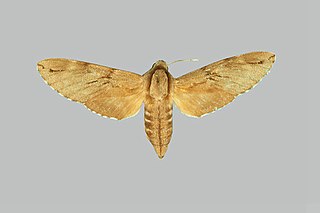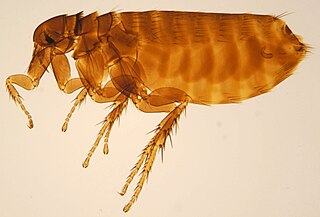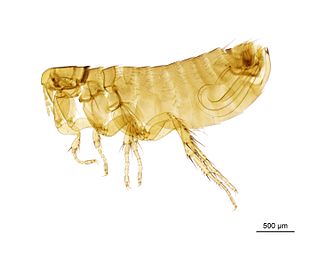
The Chinese rufous horseshoe bat is a species of bat in the family Rhinolophidae. It is found in Bhutan, China, India, Nepal, and Vietnam.

Isopogon ceratophyllus, commonly known as the horny cone-bush or wild Irishman, is a plant of the family Proteaceae that is endemic to the coast in Victoria, South Australia and on the Furneaux Group of islands in Tasmania. It is a small woody shrub that grows to 100 cm high with prickly foliage. It is extremely sensitive to dieback from the pathogen Phytophthora cinnamomi

Sphinx caligineus, the Chinese pine hawkmoth, is a moth of the family Sphingidae. It is known from Japan, north-eastern, eastern, central and southern China, South Korea, northern Thailand and southern Vietnam.

Ceratophyllus gallinae, known as the hen flea in Europe or the European chicken flea elsewhere, is an ectoparasite of birds. This flea was first described by the German botanist and entomologist Franz von Paula Schrank in 1803.

Ceratophyllus is a widespread genus of fleas found in temperate climates. Some of its members include the chicken flea, Ceratophyllus gallinae, and the poultry flea, Ceratophyllus niger.
Ceratophyllus niger, also known as the western chicken flea or the black hen flea, is an ectoparasite of birds. It is a member of the family Ceratophyllidae and was described by Fox in 1908.
Ceratophyllus breviprojectus is a species of flea in the family Ceratophyllidae. It was described by Liu, Wu and Wu in 1966.

Ceratophyllus columbae is a species of flea in the family Ceratophyllidae. It was described by Gervais in 1844.
Ceratophyllus ciliatus is a species of flea in the family Ceratophyllidae. It was described by Baker in 1904.
Ceratophyllus phrillinae is a species of flea in the family Ceratophyllidae. It was described by Smit in 1976.

Ceratophyllus garei, the duck flea, is a species of flea in the family Ceratophyllidae. It was described by Rothschild in 1902.
Ceratophyllus gilvus is a species of flea in the family Ceratophyllidae. It was described by Karl Jordan and Charles Rothschild in 1922.
Ceratophyllus qinghaiensis is a species of flea in the family Ceratophyllidae. It was described by Guangdeng and Liming in 1985.

Rubroboletus sinicus is a bolete fungus in the family Boletaceae. It is found in China. The species was first described by Wei Fan Chiu as Boletus sinicus in 1948, and transferred to the genus Tylopilus in 1979 by Fanglan Tai. In 2014, the genus Rubroboletus was created to accommodate this and allied species.

Rubroboletus is a genus of bolete fungi in the family Boletaceae. It was circumscribed by Chinese mycologists in 2014 with Rubroboletus sinicus as the type species. Species are characterized by having a reddish cap surface, yellow tubes on the underside of the cap, and an orange-red to blood-red pore surface. Pinkish to red spots (reticula) are present on the stipe surface, and a bluish color change occurs when the bolete flesh is injured. Rubroboletus mushrooms have an olive-brown spore print, and produce smooth spores. Eight species were included in the original circumscription ; five were added in 2015, and another in 2017.
Nanohammus sinicus is a species of beetle in the family Cerambycidae. It was described by Maurice Pic in 1925. It is known from China.
Pseudoechthistatus sinicus is a species of beetle in the family Cerambycidae. It was described by Bi and Lin in 2016. It is known from China.

Astragalus sinicus is a species of milkvetch in the family Fabaceae. It is known under such common names as Chinese milkvetch and is in common use in farming as a green manure. It is not to be confused with Astragalus propinquus, the plant yielding Radix Astragali for Chinese medicine.
Calanus sinicus is a copepod found in the northwest Pacific.
Tropidophorus sinicus, the Chinese water skink, is a species of skink found in China and Vietnam.








